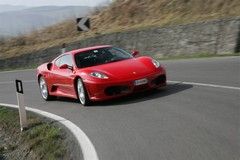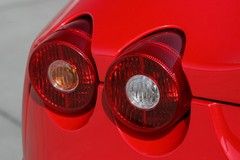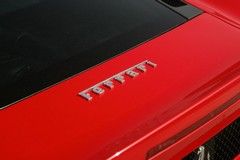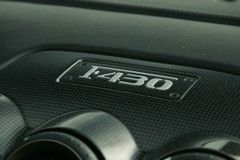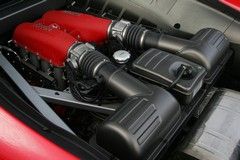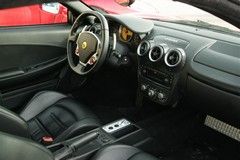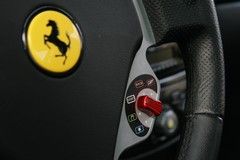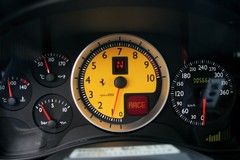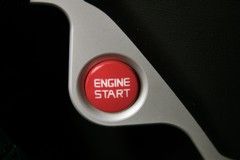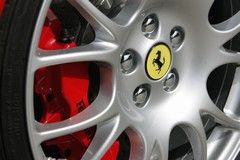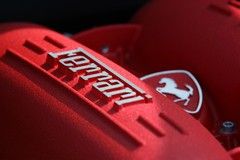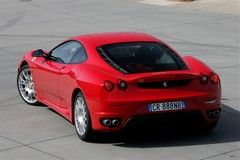Ferrari F430 F1
Ian Kuah assesses the Ferrari F430 F1 and its controversial gearshift. He likes it. A lot.
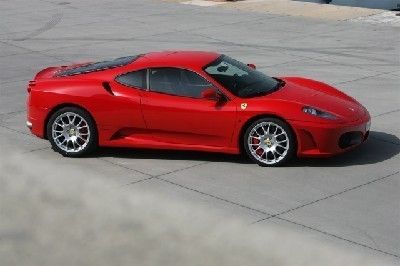
Ferrari F430 F1
Ferrari’s latest masterpiece, the F430 F1 Berlinetta is one of the best sportscars ever made. Dynamically, it completely overshadows the F360 Modena and, although it may look like a development of the earlier car, it is in fact almost completely new from the ground up.
While you might think both these cars look similar in isolation, when you line them up side-by-side, the actual differences are significant. The big front intakes of the F430 are more rounded, softening the frontal aspect even if it still looks race car aggressive in your rear mirror.
The actual size of the intakes is also disguised to some extent by the black paint around the parts of the nose cone moulding that channel air towards the black mesh grilles. Between them, a small colour-coded air-splitter helps control the air reaching the revised flat bottom. Ferrari claims 130Kg of downforce over the front axle, and 150Kg over the rear axle at 300km/h. This is a 50 per cent improvement over the F360’s numbers.
At the rear, the adoption of the Enzo shaped rear lights has effected a dramatic transformation to the rear aspect. Apart from establishing an important link with the Ferrari flagship, this new rear design moves the F430’s styling idiom from the 20th to the 21st century in one fell swoop.
The Ferrari engineers worked hard to solve the heat management problems that plagued the F360, so form follows function more closely this time. At the front, the air vents in front of the wheel arches help to extract hot air from the big water radiators, and the rear grille and cooling outlets that line the perimeter of the engine lid glass panel help to remove hot air from the engine bay.
The F430’s 90-degree V8 motor does not share any parts with the similarly configured 3,586cc 360 Modena engine. The F360 had 400bhp at 8,500rpm and 275.6lb-ft of torque at 4,750rpm, but these numbers are overshadowed by the 490bhp at 8,500rpm and 343lb-ft of torque at 5,250rpm produced by the new 4,305cc engine. Specific output is 114bhp/litre. Top speed of the 1,450Kg aluminium-bodied Berlinetta is 196mph with 0-62mph in 4.0 seconds.
The latest incarnation of the F1 clutchless paddle shift transmission made by Magneti Marelli is also significantly superior to the previous generation unit. Faster and smoother, it makes lightning quick upshifts under full throttle. There is no getting away from the kick in the back under such hard shifts, but when you are driving normally, so long as you feather the throttle during an upshift, as you would in a manual car, upshifts can be made seamless.
Completely revised suspension with adaptive damping and Ferrari’s brilliant E-Diff electronic differential help the new car deploy its power safely. With torque significantly up from the F360, acceleration out of the bends is noticeably improved and the E-Diff’s ability to perfectly apportion the power to the tarmac is felt in the way the car maintains its balance.
Despite the challenging bumpy roads and sometimes off-cambered corners of our hilly Tuscany test route, the F430 was never wrong-footed. In situations where we know the F360 could be skittish, the F430 remained secure and balanced.
The steering and chassis relationship of all Ferraris is a very direct one. But where the F360 can feel nervous and edgy at times, the F430’s steering/chassis relationship is much more linear and gives you confidence. You quickly feel at one with this car, and although you can and indeed should never relax completely in such an involving machine, its user friendliness soon puts you at ease.
The power steering is well nigh perfect, striking that elusive balance between describing the road surface, while insulating your fingers from kickback caused by surface imperfections. The ride is also surprisingly good for a mid-engined supercar, taut but well able to soak up small and large bumps with perfect bounce and rebound control.
Our test car was fitted with the optional ceramic brakes and their stopping power is beyond criticism. Importantly pedal feel is excellent and they work well from cold at town speeds too.
The sound of the flat-plane crank V8 is incredible. We never felt comfortable with the high-pitched scream of the F360’s motor; there is simply too much high frequency action going on for comfort over distance. With more bass in its soundtrack, the F430’s aural signature strikes a nice balance between the F360 and the F355. It is easier to live with and far more appealing.
On top of all that engaging stuff built into the chassis and engine, the F430 has another trick up its sleeve, courtesy of electronic wizardry. If you have ever seen the steering wheel of a Formula One car, you will have noticed the half dozen buttons and switches on it that control functions from the pit lane speed limiter to the brake balance.
Some may think that moving the Start button to the steering wheel is pretentious, but it is better off there than on the centre console where it usually appears on cars with more luxurious intent.
However, no tifosi is going to moan about the ‘manettino’ switch (as it is called by the Ferrari racing team) that alters the gearshift, engine e-gas electronic throttle response and traction control protocols from the ICE setting for snow. through low grip road surfaces like gravel, to the normal Sport position to the faster and more aggressive Race setting. The final setting disengages all electronic traction and stability aids apart from ABS entirely for the track.
The system works brilliantly in the real world, tailoring the cars responses to your mood and road conditions. So when this fantastic motor reaches its crescendo between 7,000 and 8,500rpm, and upshifts nearly as quickly as an F1 car, there is no getting away from the fact that this is a red-blooded, race-bred Ferrari. Bellissimo!
Gassing Station | Supercar General | Top of Page | What's New | My Stuff

